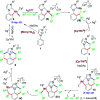C-H activation-annulation on the N-heterocyclic carbene platform
- PMID: 35542736
- PMCID: PMC9084354
- DOI: 10.1039/c8ra03799j
C-H activation-annulation on the N-heterocyclic carbene platform
Abstract
Ring-fused cationic N-heterocycles are an important class of organic compounds recognized to be of significant interest in diverse research areas including bioactivity, materials chemistry, supramolecular chemistry, etc. Toward the synthesis of such molecules, recently unique chemistry has been explored utilizing a novel conjugative action of NHC ligands as a functionalizable directing group in rhodium(iii)-catalyzed aromatic/heteroaromatic/non-aromatic C-H activation and subsequent annulation of various imidazolium salts with internal alkynes. This review highlights the initial development and underscores the potential of this chemistry.
This journal is © The Royal Society of Chemistry.
Conflict of interest statement
The authors declare no conflict of interest.
Figures
























References
-
- Arduengo III A. J. Harlow R. L. Kline M. J. Am. Chem. Soc. 1991;113:361. doi: 10.1021/ja00001a054. - DOI
-
- Hopkinson M. N. Richter C. Schedler M. Glorius F. Nature. 2014;510:485. doi: 10.1038/nature13384. - DOI - PubMed
- Melaimi M. Soleilhavoup M. Bertrand G. Angew. Chem., Int. Ed. 2010;49:8810. doi: 10.1002/anie.201000165. - DOI - PMC - PubMed
- Droge T. Glorius F. Angew. Chem., Int. Ed. 2010;49:6940. doi: 10.1002/anie.201001865. - DOI - PubMed
- Poyatos M. Mata J. A. Peris E. Chem. Rev. 2009;109:3677. doi: 10.1021/cr800501s. - DOI - PubMed
- Hahn F. E. Jahnke M. C. Angew. Chem., Int. Ed. 2008;47:3122. doi: 10.1002/anie.200703883. - DOI - PubMed
-
- Díez-González S. Marion N. Nolan S. P. Chem. Rev. 2009;109:3612. doi: 10.1021/cr900074m. - DOI - PubMed
- Herrmann W. A. Angew. Chem., Int. Ed. 2002;41:1290. doi: 10.1002/1521-3773(20020415)41:8<1290::AID-ANIE1290>3.0.CO;2-Y. - DOI - PubMed
- Zou T. Lok C. Wan P. Zhang Z. Fung S. Che C. Curr. Opin. Chem. Biol. 2018;43:30. doi: 10.1016/j.cbpa.2017.10.014. - DOI - PubMed
- Elie M. Renaud J.-L. Gaillard S. Polyhedron. 2018;140:158. doi: 10.1016/j.poly.2017.11.045. - DOI
- Oehninger L. Rubbiania R. Ott I. Dalton Trans. 2013;42:3269. doi: 10.1039/C2DT32617E. - DOI - PubMed
- Hindi K. M. Panzner M. J. Tessier C. A. Cannon C. L. Youngs W. J. Chem. Rev. 2009;109:3859. doi: 10.1021/cr800500u. - DOI - PMC - PubMed
- Arnold P. L. Casely I. J. Chem. Rev. 2009;109:3599. doi: 10.1021/cr8005203. - DOI - PubMed
-
- Kuhn N. Al-Sheikh A. Coord. Chem. Rev. 2005;249:829. doi: 10.1016/j.ccr.2004.10.003. - DOI
Publication types
LinkOut - more resources
Full Text Sources

